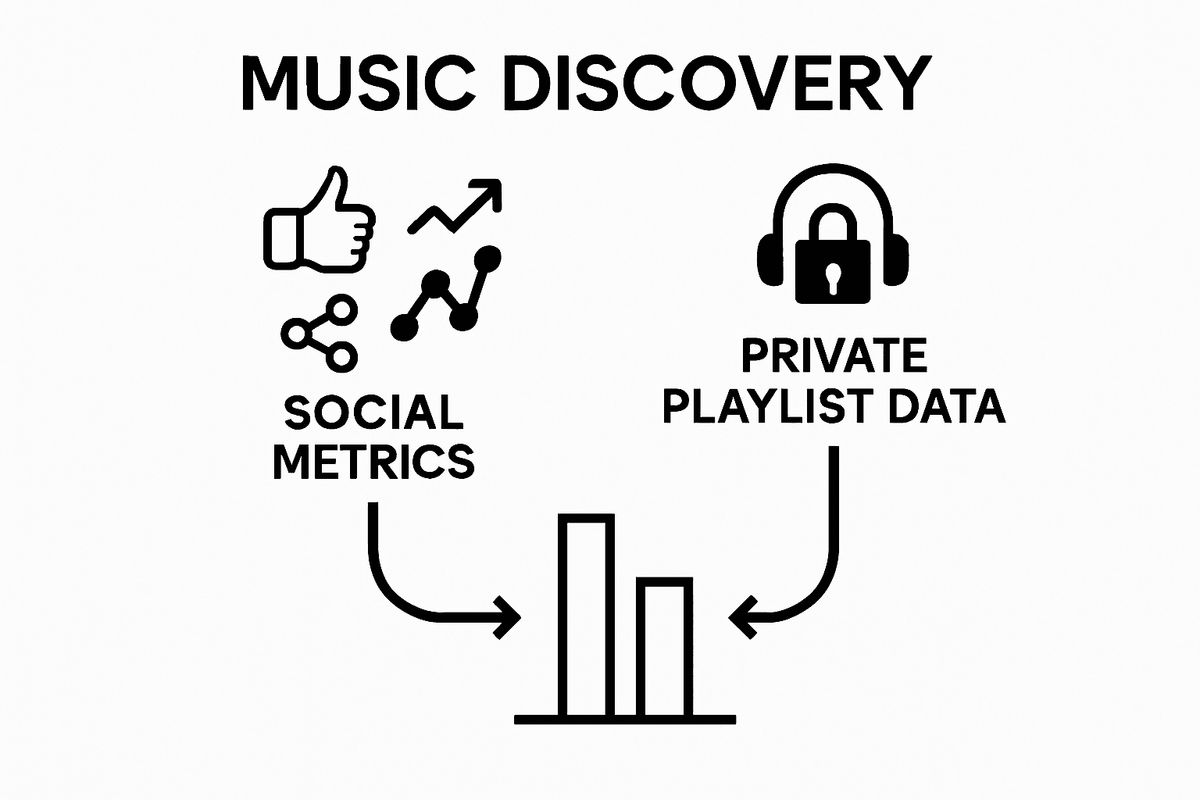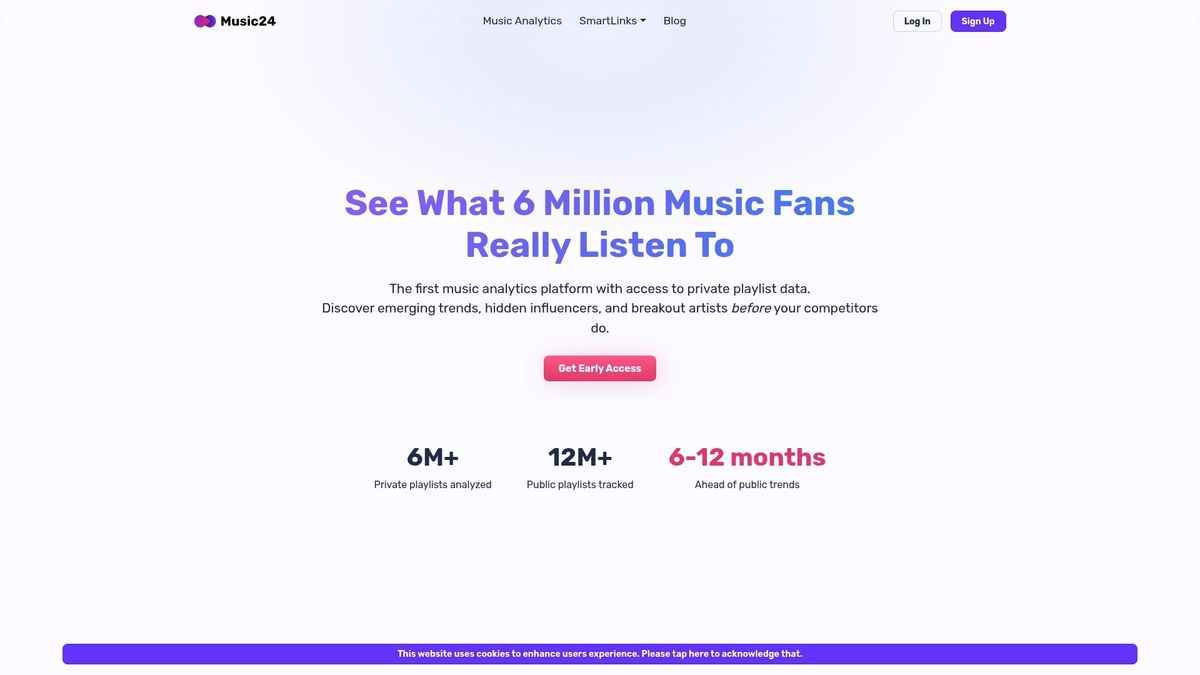Music discovery shapes how millions of listeners find their next favorite song every day. It sounds like all the magic comes from social metrics such as likes or streaming counts. But the surprise is that these numbers often hide the real story. The most powerful insights about what people truly love can be found in private playlist data, which reveals authentic taste far beyond what public stats ever could.
Table of Contents
- The Concept Of Music Discovery: An Overview
- The Role Of Social Metrics In Music Discovery
- Limitations Of Relying Solely On Social Metrics
- Alternative Methods For Music Discovery
- Strategies For Effective Music Discovery Beyond Metrics
Quick Summary
| Takeaway | Explanation |
|---|---|
| Music discovery is an active process. | It involves engaging with music through personal exploration rather than passive listening. |
| Technological tools enhance discovery. | Algorithms, playlists, and social media create new opportunities for discovering diverse music. |
| Social metrics have limitations. | They often reflect superficial interactions that may misrepresent genuine listener engagement. |
| Private playlists reveal true preferences. | Analyzing personal playlists provides insights that public metrics cannot capture. |
| Combine data sources for deeper insights. | Effective strategies integrate qualitative and quantitative data for a fuller understanding of music trends. |
The Concept of Music Discovery: An Overview
Music discovery represents a dynamic process through which listeners encounter and engage with new musical experiences. At its core, this phenomenon transcends mere passive listening and transforms into an active exploration of sonic landscapes.
The Fundamental Nature of Music Discovery
Music discovery is fundamentally about connection and personal musical journey. Unlike traditional consumption methods, modern music discovery involves intricate interactions between listeners, technology, and creative content. Researchers from UC Irvine define music discovery as a multifaceted process where individuals encounter and form meaningful relationships with previously unknown musical compositions.
The process involves several critical components:
- Psychological curiosity about new sound experiences
- Technological platforms enabling musical exploration
- Personal taste development and refinement
- Cultural and social influences on musical preferences
Evolving Mechanisms of Musical Exploration
Traditionally, music discovery occurred through radio, recommendations from friends, or physical record stores. Contemporary methods have dramatically expanded, incorporating algorithmic recommendations, curated playlists, social media platforms, and specialized music analytics tools. These technological advancements have democratized music exploration, allowing listeners unprecedented access to diverse musical genres and emerging artists.
Understanding music discovery requires recognizing its complexity beyond surface-level interactions. It is not simply about finding new songs but about creating meaningful connections with musical expressions that resonate personally. For industry professionals, comprehending these nuanced discovery patterns becomes crucial in identifying emerging trends and understanding listener behaviors.
Professionals can read more about advanced music data interpretation to gain deeper insights into these intricate discovery mechanisms. By analyzing private playlist data and understanding listener behaviors, music industry experts can uncover authentic discovery patterns that extend far beyond traditional public metrics.
The table below compares public social metrics with private playlist analytics, summarizing their core features, limitations, and unique insights for understanding music discovery.
| Aspect | Public Social Metrics | Private Playlist Analytics |
|---|---|---|
| Data Visibility | Publicly visible (likes, shares, streams) | Private, user-curated collections |
| Representation of Preferences | Surface-level; can be influenced by trends | Reflects authentic, personal taste |
| Manipulation Risk | High (susceptible to bots, promotions) | Low (harder to manipulate, more genuine data) |
| Trend Detection | Indicates widespread trends | Detects emerging/niche genres early |
| Demographic & Contextual Insights | Limited demographic/contextual granularity | Richer context from user segmentation |
| Influence on Discovery Algorithms | Often shapes algorithms, creating bias | Offers unbiased discovery patterns |
| Depth of Listener Engagement | Shallow; may not indicate deep connection | Deep engagement; reflects meaningful choices |
The Role of Social Metrics in Music Discovery
Social metrics have become a pivotal mechanism for understanding music consumption patterns and listener engagement in the digital age. These quantitative indicators provide insights into how musical content spreads, gains popularity, and connects with audiences across various platforms.
Understanding Social Metric Landscape
Social metrics encompass a range of digital indicators that track musical content interactions. Research from Spotify suggests these metrics include likes, shares, comments, playlist inclusions, streaming numbers, and cross-platform engagement rates. They serve as digital breadcrumbs revealing how listeners interact with and discover new music.
Key components of social metrics include:
- Total streaming volume
- User engagement rates
- Cross-platform sharing behaviors
- Playlist inclusion frequency
- Listener demographic interactions
Limitations of Surface-Level Social Metrics
While social metrics offer valuable initial insights, they present significant limitations in truly understanding music discovery. These metrics often represent surface-level interactions that do not capture the depth of listener connection or authentic musical exploration. Public metrics can be manipulated, creating artificial popularity that does not reflect genuine listener interest.
Professional music analysts recognize that relying exclusively on social metrics provides an incomplete picture of music discovery. Public-facing numbers frequently fail to capture the nuanced, private interactions that genuinely indicate emerging musical trends. Learn how to detect music trends more effectively, moving beyond simplistic social media measurements.
The most sophisticated music discovery strategies integrate multiple data sources, combining social metrics with private playlist analysis, listener behavior tracking, and contextual musical ecosystem insights. This comprehensive approach allows industry professionals to understand not just what music is being shared, but how and why listeners are forming meaningful connections with new musical experiences.
Limitations of Relying Solely on Social Metrics
Social metrics, while seemingly comprehensive, present significant constraints in understanding the genuine landscape of music discovery. These metrics often create a narrow and potentially misleading representation of musical engagement and listener preferences.
The Algorithmic Bias Problem
Research from Humanities Commons reveals that social metrics can systematically marginalize emerging artists and underrepresented genres. The algorithmic systems driving these metrics tend to create echo chambers that amplify already popular content, effectively suppressing diverse and innovative musical expressions.
Key algorithmic biases include:
- Preferential treatment of already viral content
- Demographic skew in recommendation systems
- Reward mechanisms that favor mainstream sounds
- Limited representation of niche musical genres
- Artificial inflation through paid promotions
The Illusion of Popularity
Public metrics frequently construct an artificial popularity narrative that does not reflect authentic listener connections. Streaming numbers, likes, and shares can be manipulated through targeted marketing campaigns, bot networks, and strategic promotional techniques. These manufactured interactions create a distorted view of musical relevance that fails to capture the nuanced, personal nature of true music discovery.
Professional music analysts understand that genuine musical impact transcends quantitative metrics. The most meaningful musical experiences are often private, personal, and cannot be adequately measured by public-facing indicators. Explore advanced strategies for private playlist analysis to gain deeper insights into authentic listener behaviors.
The most sophisticated approach to understanding music discovery requires a multifaceted analysis that combines social metrics with qualitative research, private playlist data, listener behavior tracking, and contextual musical ecosystem insights. By moving beyond surface-level metrics, industry professionals can develop a more comprehensive and accurate understanding of emerging musical trends and listener preferences.
The following table breaks down key limitations of relying solely on social metrics in music discovery, highlighting types of bias and resulting challenges for music professionals.
| Limitation | Description | Impact on Music Discovery |
|---|---|---|
| Algorithmic Bias | Prefers already viral or popular content | Emerging/niche artists are sidelined |
| Artificial Popularity | Easy to inflate likes, streams, and shares | Misleading picture of genuine engagement |
| Demographic Skew | Biased toward dominant user segments | Underrepresentation of diverse preferences |
| Surface-Level Engagement | Tracks passive actions, not deep connections | Misses authentic listener relationships |
| Promotional Manipulation | Susceptible to paid campaigns and bots | Distorts true taste and trend detection |
Alternative Methods for Music Discovery
Traditional social metrics represent only a fragment of the complex music discovery ecosystem. Progressive approaches now emphasize deeper, more nuanced methodologies that capture authentic listener experiences and emerging musical trends beyond surface-level interactions.
Private Playlist Analytics
Research from MIT Media Lab indicates that private playlist data offers significantly more meaningful insights into genuine musical preferences compared to public metrics. These personal collections represent unfiltered listener choices, revealing intricate musical taste formations and discovery patterns that remain invisible in public-facing platforms.

Key advantages of private playlist analysis include:
- Unbiased representation of listener preferences
- Capture of niche and emerging musical trends
- Identification of genuine listener connections
- Detailed cross-genre exploration patterns
- Early detection of potential breakout artists
Contextual Music Ecosystem Mapping
Contextual music discovery transcends traditional measurement techniques by examining the broader musical ecosystem. This approach integrates multiple data points including listener demographics, geographical influences, cultural contexts, and interconnected musical networks. Sophisticated music intelligence platforms now analyze these complex interactions to understand how musical discoveries truly propagate.
Professional music analysts recognize that authentic musical exploration involves understanding the intricate relationships between artists, genres, listener communities, and cultural movements. Explore advanced playlist trend detection methods to gain deeper insights into these sophisticated discovery mechanisms.
The most advanced music discovery strategies combine technological analysis with human understanding. By integrating machine learning algorithms, cultural anthropology principles, and granular data tracking, industry professionals can develop a multidimensional view of how musical experiences are created, shared, and transformed across different listener communities.
Strategies for Effective Music Discovery Beyond Metrics
Effective music discovery requires a holistic approach that transcends traditional quantitative measurements. Professionals in the music industry must develop comprehensive strategies that capture the nuanced, dynamic nature of musical exploration and listener engagement.
Diversified Discovery Methodologies
Research from Expert Systems with Applications emphasizes the importance of multi-channel music discovery approaches. These strategies involve creating robust, interconnected systems that leverage both technological tools and human cultural insights.
Key components of comprehensive discovery strategies include:
- Integration of algorithmic and human curation
- Cross-platform data aggregation
- Contextual listener behavior analysis
- Cultural and geographical trend mapping
- Qualitative interaction tracking
Human-Centered Discovery Frameworks
The most sophisticated music discovery approaches recognize that technological tools are supplementary to human experience. Professional music analysts understand that authentic musical connections cannot be fully captured by algorithms or metrics alone. This requires developing frameworks that prioritize listener context, emotional resonance, and cultural significance.
Learn how to leverage advanced playlist trend detection to understand the intricate dynamics of musical exploration. These approaches move beyond simplistic data points to create a more holistic understanding of how listeners truly discover and connect with music.
Advanced music discovery strategies combine machine learning technologies with deep cultural understanding. By integrating sophisticated data analysis, anthropological insights, and nuanced listener tracking, industry professionals can develop more authentic and meaningful approaches to understanding musical preferences and emerging trends. The goal is not just to predict listener behavior but to comprehend the complex, emotional journey of musical discovery.

Move Beyond Social Metrics With True Music Discovery Insights
Are you struggling to identify the next breakout artist or decipher genuine music trends while lost in a sea of manipulated social metrics and surface-level data? The article highlights how traditional public numbers often hide authentic listener engagement and real discovery patterns. This can leave professionals making big decisions based on incomplete information. If you want to see past algorithmic biases and misleading popularity, you need a solution that reveals what is really resonating with audiences before it hits the mainstream.

Stop relying on outdated models. See what emerging genre blends, influential curators, and rising artists are trending right now by analyzing private playlists where music discovery actually happens. Visit Music24.com to uncover predictive analytics and private playlist intelligence you cannot get anywhere else. If you are serious about building your edge in artist development and music marketing, explore Music24 today and start making informed, data-driven decisions before your competition catches on.
Frequently Asked Questions
What is music discovery?
Music discovery is the process through which listeners find and engage with new music, forming meaningful connections with songs and artists through various methods, including technology and personal exploration.
How have music discovery methods evolved over time?
Traditionally, music discovery happened through radio, friends' recommendations, or record stores. Nowadays, it incorporates algorithmic recommendations, curated playlists, and social media, providing listeners with access to diverse music and emerging artists.
Why are social metrics not enough for understanding music discovery?
Social metrics often reflect only surface-level interactions, such as likes and shares, which fail to capture the depth of genuine listener connections. They can also be manipulated, creating an inaccurate picture of popularity and engagement.
What alternative methods can improve music discovery?
Alternative methods include private playlist analytics, which provide deeper insights into listener preferences, and contextual music ecosystem mapping, which considers the broader influences and relationships within the music community.
Recommended
- How to Detect Music Trends Early and Stay Ahead in 2025 - Blog - Music24.com
- Understanding the Guide to Music Data Interpretation - Blog - Music24.com
- How to Leverage Private Playlist Data for Artist Growth - Blog - Music24.com
- Understanding the Role of Social Media in SEO
- X.com For Musicians:【Strategies To Promote Music In 2025】


